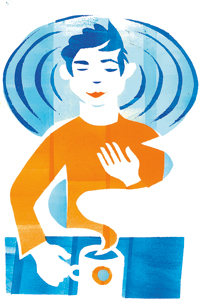Bodhidharma tore off his eyelids. Jack Kornfield’s teacher told him to meditate at the edge of a well. The Buddhist tradition is full of stories of practitioners who have found unique techniques for stimulating and maintaining their practice. In fact, anyone who has sat on a zafu more than once probably came up with a trick or two for staying there. To tap into this resource, we’ve asked seasoned Buddhist teachers and longtime practitioners to share their favorite meditating tools. Check out what they have to offer.
 1 Just get in the posture
1 Just get in the posture
“Try making a commitment to getting into the meditation posture at least once a day. You don’t have to sit for any particular length of time, just get on the cushion. A lot of times, the hardest part is getting there. Once you’re sitting down, you think, ‘I might as well sit for a few minutes,’ and more often than not, you’re getting full sessions in.” —Insight Meditation Society co-founder Joseph Goldstein
2 Reflect on the big picture
“The breath is not only a useful object of concentration but also a sign of life. A little reflection can bring a sense of gratitude and delight to each breath, which is further enhanced by sensing what the Indian mystic and poet Kabir called ‘the breath within the breath,’ the mystery that is riding along on each inhale and exhale.” —Author and meditation teacher Wes Nisker
3 Use a timer
“When you sit in meditation, use a timer instead of a clock. If you have to keep opening your eyes to check on the time, restlessness can be exacerbated. By using a timer, one frees oneself from the concept of time and discovers a deepening of relaxation and a sense of the timeless.” —Cambridge Insight Meditation teacher Narayan Liebenson Grady
 4 Get your priorities straight
4 Get your priorities straight
“If meditation is a priority, then it’s helpful to take that word literally and put meditation first. An example would be my rule of not turning on the computer before I’ve meditated. Simple, but effective. Probably the most trenchant advice I ever heard was in eight words from Suzuki Roshi: ‘Organize your life so you can sit well.’” —Senior Shambhala teacher David Schneider
5 Be patient
When you plant seeds in the garden, you don’t dig them up every day to see if they have sprouted yet. You simply water them and clear away the weeds; you know that the seeds will grow in time. Similarly, just do your daily practice and cultivate a kind heart. Abandon impatience and instead be content creating the causes for goodness; the results will come when they’re ready.” —Tibetan Buddhist nun and author Bhikshuni Thubten Chodron
6 Play with postures
“Even though we generally refer to meditation as ‘sitting,’ when you find that hard to do, you can also ‘sit’ lying down. When I wake up at night with insomnia, I pay attention to the breath or do lovingkindness practice. One year, I could only get myself to ‘sit’ by lying on the ground in the backyard, sensing the layers of the earth, and listening to the sounds of a garden in the city.” —Barbara Gates, co-editor of the journalInquiring Mind
7 Make a vow
“Don’t give yourself a choice. Don’t ask yourself: ‘Do I want to get up and do this?’ because you will think of a million other things to do. Just set your alarm and get up and meditate—no questions. It also helps to make a vow. Try promising the Buddhas that you’ll meditate every day for a month and see what happens.” —Tibetan Buddhist nun and author Ani Tenzin Palmo
 8 Use incense
8 Use incense
“Time a stick of incense. Once you know how long it takes to burn, you can use it to determine the lengths of your sessions.” —Tricycle founder Helen Tworkov
9 Widen your practice field
“Don’t put arbitrary limits on the field of practice. Trying to live graciously, reading and reflecting wisely, appreciating virtue in others, not making those around you miserable, being a mensch—practicing in this way, which is pretty traditional, there is never a lack of opportunity. As for sitting meditation itself—that’s something we do for others, so that maybe we can have a more generous spirit and be less of a pain in the neck.” —Tricycle editor-at-large Andy Cooper
10 Still the mind in unusual positions
“I like to interpret what the Buddha said when he talked about the four postures suitable for meditation—seated, standing, walking, and lying down—as an invitation to watch the mind in any position, any place, any time. I begin my practice periods with a breathing practice from my teacher Mingyur Rinpoche; then I get into a yoga posture and stay in it for some time. Working in this way, I can watch my mind play around with discomfort, effort, desire, and aversion. Plus I receive the benefits of the pose by staying in it longer.” —Vajra Yoga founder Jill Satterfield
 11 Sit with others
11 Sit with others
“Find others to sit with. Sometimes showing up for others is easier than showing up for yourself.” —Tricycle editor and publisher James Shaheen
12 Make the right decision
“Every practitioner I know who has been able to continue to practice for years has had to deal with their resistance to sitting. It seems that when we hurl ourselves in a particular direction with vigor and intention, we are also creating a shadow of resistance at the same time. This matter is resolved over time by the decisions we make in the immediate situation: do we watch TV or sit? Do we schedule a date with a friend during our usual sitting time? Do we skip our sangha night when our parents visit or do we ask them to join us (or excuse us)? Deciding to sit over and over again through every possible seduction establishes the vigor of our intention.” —Russian River Zendo teacher Darlene Cohen
 13 Experiment with the breath
13 Experiment with the breath
“My teacher Than Geoff has always reminded me that when the mind is fighting the meditation, ask it, ‘What kind of breath would feel really good right now?’ It tricks you into experimenting with the breath, and usually the breath becomes interesting enough and pleasurable enough that concentration can settle in.” —Tricycle contributing editor Mary Talbot
14 Drink coffee
“Some people say that it was actually Buddhist monks who discovered coffee. The story goes that they were wandering around in the forest somewhere when they came across the beans. They started chewing them and thought, ‘These are great. we can use this energy for our meditation practice.’ If you are going to get up in the morning and sit, it doesn’t have to be first thing. Get up and have a cup of coffee if it helps. It’s when you start taking out the newspaper and doing other stuff that you lose the freshness of mind you have when you first wake up. But if you can have coffee without turning on your cell phone, go for it.” —Downtown Meditation Community teacher Peter Doobinin
 15 Sit because you need to
15 Sit because you need to
“I’d say to meditators pretty much what Rilke said to poets: don’t do it unless you have to! In my little experience, any other motivation than necessity demeans meditation to a conceit, another tool for ego-consolidation of one form or another. Not for nothing is the first point of the Big B: There is SUFFERING. That’s the one and only actual gate.” —Contributing editor Eliot Fintushel
16 Don’t cheat
“If you’re counting the breaths, for example, don’t let it be Enron style. An honest accounting works wonders for the spiritual bottom line.” —Contributing editor Mark Magill
17 Tune up by reading something you love
“I don’t mean a text that you’re studying—you don’t want to encourage the mind to cogitate. Near the place where you like to sit, keep a little selection of readings that inspire happiness or quiet; they can be from any tradition. Recently I’ve had by my side Thomas Merton’s Thoughts in Solitude, the Avadhuta Gita, and a folder of short poems and quotations from past issues of Tricycle and other sources. For a session when the mind is really stirred up, here’s a wonderful quote to put it in pause mode, from the mind training teachings in The Great Path of Awakening:
When I am in this kind of mood
My mat is by far the best place to be.
This present mental state is fine.
Moreover, by putting up with this unpleasantness,
I won’t be born in the hell realms. How wonderful!
I won’t be baked or roasted. How wond rful!”
rful!”
—Tricycle copyeditor Karen Ready
18 Check in before you start
“Once you sit down, in addition to doing a quick scan of your body for tension, take a moment to look at your heart and mind before you ‘start’ officially. Sure, maybe you just rolled out of bed, but what is your mood like—annoyed? Excited (or anxious) at the prospect of a new day? Is your brain still in slo-mo, or was it jolted into a panic by the alarm clock? It can be good to notice where you’re at before you start counting breaths.” —Associate editor Andrew Merz
19 Have faith
“Seek the support of a Power Beyond the Self. Dogen says, ‘Throw body and mind into the house of Buddha, so that all is done by Buddha.’ If we rely only upon our own resources in trying to develop a meditation practice, we will quickly exhaust ourselves. It is important to know that the Buddha himself supports us in all kinds of ways, some easy to recognize (through the teaching passed down from master to disciple, for instance), and some not. Some of those supports become visible to us only when we believe in the Buddha. Belief in Buddhahood as a Power Beyond the Self can encourage us when nothing else seems to work. That statue on your altar isn’t just a decorating idea.” —Contributing editor Clark Strand
20 Don’t push
“There’s an old Zen saying, ‘When you sit Buddha, you kill Buddha.’ Whatever else it might mean about blowing away preconceptions or that kind of thing, it always stuck with me as a very friendly reminder not to try too hard, or push too hard, don’t try to be a Buddha when you’re sitting.” —Tricycle webmaster Philip Ryan
21 End carefully
“When you end your meditation, be very careful with how you open your eyes. Try to maintain your center inside rather than letting it flow outside. Then, maintaining your center, get up from the cushion and keep the center inside as long as you can. As my teacher Ajaan Fuang instructed: ‘When you start out sitting in meditation, it takes a long time for the mind to settle down, but as soon as the session is over you get right up and throw it away. It’s like climbing a ladder slowly, step by step, to the second floor, and then jumping out the window.’” —Metta Forest Monastery Abbot Thanissaro Bhikkhu
Thank you for subscribing to Tricycle! As a nonprofit, we depend on readers like you to keep Buddhist teachings and practices widely available.